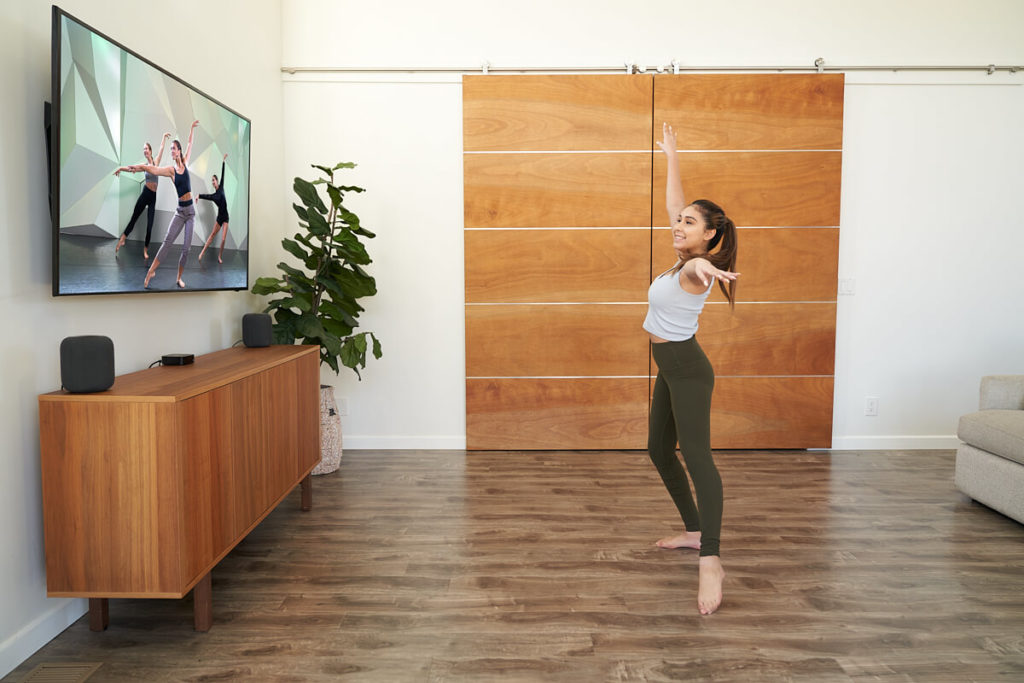One of the essential ingredients to learning dance at home is setting up your own dance space. Regardless of your skillset or the specific genre of dance that you are learning, every student learning to dance online needs a home dance space to practice their moves.
But, what is your space supposed to look like? How is it supposed to function? And perhaps most importantly, what do you need to do to create your at-home dance studio? Here are some helpful tips and great ideas to get you set up in style.
Location is Key
Make sure that your home dance studio is in a place where you can comfortably move and practice without interruption or inconvenience. This is your personal dance space, so we’re talking about a spot that easily accommodates your full range of motion without having to avoid clutter or duck under a light fixture or fan on a low-hanging ceiling.
Speaking of light, you are going to want lots of it. Bright light is best but if you can’t make that work just be sure you have enough natural light to see what you’re doing. Track lighting and LED technology are surprisingly illuminating, warm-looking, and affordable these days. Plus they set a mood that can be fun for getting into the class you’re taking. Keep your eyes peeled for sales and deals and make your dance studio at home glow.
Focus on Flooring
The surface that you dance on is every bit as important as your footwear and clothing. Carpet isn’t the best material for a dancer to work on, but it’s doable if it’s all you’ve got! Carpets can absorb shock better than harder surfaces like a concrete floor, but you do lose the ability to turn and slide across the floor easily. If you are doing floorwork, you’ll want to cover your skin to avoid rug burns!


Smooth floors will more closely resemble the Marley material you will find in dance studios. If you can opt for a space in your home with a wooden floor. Wood floors are the OG of professional dance studios, so you’ll feel right “at home” as you practice dance. One of our CLI dance studios even has wooden flooring, too!
If you’re willing to invest in your dance floor, consider prefabricated laminate flooring or a small section of Marley you can roll out when you’re dancing. It’s inexpensive, easy to install, and comes in many options and textures that you can customize to your preference. You’ll want something with a little give and bounce, so a padded underside is a good feature to look for.
The Magic of Sound and Vision
Being a virtual dance student means relying on the internet and your Wi-Fi-connected devices to host your dance classes as smoothly as possible. So, you are going to want to invest a little time and money in getting your audiovisual set up just right.
You don’t have to drop a ton of money on a giant flatscreen TV to project your lessons, but a larger, mountable monitor that lives at eye level when you are standing up is a standard and affordable feature that you can choose to include in your home dance studio. However, anything that you can do to make it easier to freeze, slow down, and playback videos easier is also important. Consider putting your computer or laptop in an elevated place where it is secured against potential damage by the vibrations created by your dancing. Having your workstation near your router is a good idea as well, as you are going to want a strong and fast Wi-Fi signal.


Once you have your computer and visual setup dialed in, you’re going to want to focus on creating a good sound system. Make sure that your speakers have a decent quality to work in your own dance studio. You don’t have to blast the neighborhood out with subwoofers and massive volume, but you do want to be able to hear what your instructor is saying and the music that you dance to with clarity and balance. Make certain that your sound system is similarly secured against vibrations and not in your way. Mounting your speakers in the corners of your ceiling, facing downward at a slight angle is a good general installation practice.
(P.S. Using headphones? That’s okay too, but wireless is best!)
Bare Walls? No! Barre Walls? Maybe!
It should go without saying that for a dancer to competently practice and improve their skills, they need to be able to see themselves move. Having mirrors in your home studio is essential. Ideally you would have tall-wide, wall-mounted full-length mirrors as a dance studio would. If that’s not in your budget, a wall mirror will work fine. Just position it so you can watch your whole body. Easy to install full-length mirror paneling is an affordable option out there, but the important thing is to make sure that the reflective surfaces are clear, clean, not warped, and safely mounted to your walls.


And while not necessary for every dancer, if you are a budding student of ballet, you should consider installing ballet barres for warm-ups and practice. Creating your own ballet barre can actually be done very easily with some simple PVC pipe! But, you can just as easily use a chair, desk, or table to support you in your ballet barre exercises too. Building out your own dance space to practice at home can be a fun, exciting, and inexpensive job! Don’t be afraid to ask for help from a friend or family member when setting up your space. Always make sure that you focus on safety first as well as function.
Now that your at home studio is set up, start dancing with CLI Studios online!

